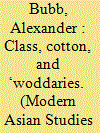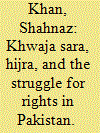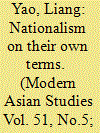|
|
|
Sort Order |
|
|
|
Items / Page
|
|
|
|
|
|
|
| Srl | Item |
| 1 |
ID:
155916


|
|
|
|
|
| Summary/Abstract |
During the 1920s, a new genre of didactic poems prescribing the proper Islamic practice of everyday peasant lives were published out of printing presses in deltaic, eastern Bengal's small towns. This article argues that these printed poems constituted a discourse of agrarian Islam that prescribed reforms in peasant material life—work, commerce, consumption, attire, hairstyle, and patriarchal authority—as a means of ensuring the viability of peasants’ market-based livelihoods. The article examines the emergence of a small-town Muslim intelligentsia that authored and financed the publications of these poems out of the Bengal delta's small-town printing industry. Eschewing communalism as an analytical frame in understanding South Asian Muslim identities, this article argues that Bengali peasant Muslim subjectivity was located in peasant engagements with agrarian markets. Agrarian Islamic texts urged Muslim cultivators to be good Muslims and good peasants, by working hard, reducing consumption, and balancing household budgets.
|
|
|
|
|
|
|
|
|
|
|
|
|
|
|
|
| 2 |
ID:
155914


|
|
|
|
|
| Summary/Abstract |
This article argues that China's New Culture Movement was not a movement, but a buzzword. It was coined by little-known intellectuals in the summer of 1919 and then used by them to sell their own, long-standing agendas. Even though they declared famous intellectuals such as Hu Shi and Chen Duxiu to be the movement's ‘centre’ and inspiration, some of them were as, if not more, important in shaping the discourses surrounding the expression ‘New Culture Movement’. Drawing upon newspapers, journals, and conference reports, this article shows this using the example of two case studies, both of which marketed their agendas as ‘New Culture Movement’: the Jiangsu Educational Association, which was a political-educational group in Jiangsu; and Chinese Christian intellectuals around the Apologetic Group in Beijing.
Regarding the New Culture Movement as a buzzword addresses some puzzles about it. It explains why it has proven difficult to agree on a starting and endpoint for the New Culture Movement. It also illustrates why such a huge variety of ideas, whose complexity has become ever more evident in recent scholarship, was subsumed under the one headline of ‘New Culture Movement’.
|
|
|
|
|
|
|
|
|
|
|
|
|
|
|
|
| 3 |
ID:
155918


|
|
|
|
|
| Summary/Abstract |
This article makes use of a recently unearthed archive in Sweden, complemented by research in the India Office Records and Maharashtra State Archives, to explore the business networks of the small-scale railway contractor in 1860s Bombay Presidency. The argument centres on the career of one individual, comparing him with several contemporaries. In contrast to their civilian colleagues, freebooting engineers have been a somewhat understudied group. Sometimes lacking formal technical training, and without an official position in colonial India, they were distrusted as profiteering, even corrupt, opportunists. This article will present them instead as a diverse professional class, incorporating Parsis alongside various European nationalities, who became specialists in local milieux, sourcing timber and stone at the lowest prices and retaining the loyalty of itinerant labourers. It will propose that the 1860s cotton boom in western India provided them with a short-lived window of opportunity in which to flourish, and to diversify into a variety of speculative enterprises including cotton trading, land reclamation, and explosives. The accidents and bridge collapses of the 1867 monsoon, and subsequent public outcry, will be identified as a watershed after which that window of opportunity begins to shut. The article's concluding section analyses the contractors’ relationship with their labour force and its intermediary representatives, and strategies for defusing strikes. Ultimately, small independent contractors were agents of modernity not formally affiliated with the imperial project, and forced to bargain with merchants and strikers without official backing. Theirs is a record of complex negotiations at the local level, carried out in the immediate post-Mutiny settlement.
|
|
|
|
|
|
|
|
|
|
|
|
|
|
|
|
| 4 |
ID:
155922


|
|
|
|
|
| Summary/Abstract |
This article discusses the way in which assemblages of technologies, political institutions, and practices of exchange have rendered both language and script a site for an ongoing politics of authority among Santals, an Austro-Asiatic speaking Adivasi (Scheduled Tribe) community spread throughout eastern India. It focuses particularly on the production of Santali-language print artefacts, which, like its dominant language counterparts, such as Bengali, has its roots in colonial-era Christian missions. However, unlike dominant languages, Santali-language media has been characterized by the use of multiple graphic registers, including a missionary-derived Roman script, Indic scripts such as Devanagari and Eastern Brahmi, and an independently derived script, Ol-Chiki. The article links the history of Santali print and graphic practice with assertions of autonomy in colonial and early post-colonial India. It then ethnographically documents how graphic practices, in particular the use of multiple scripts, and print technologies mediate a contemporary politics of authority along vectors such as class and generation within communities that speak and read Santali in the eastern state of West Bengal, India.
|
|
|
|
|
|
|
|
|
|
|
|
|
|
|
|
| 5 |
ID:
155917


|
|
|
|
|
| Summary/Abstract |
This article analyses the role of the legal profession and the evolution of aspects of Indian nationalist ideology during the Non-Cooperation Movement of 1920–22. Very few legal professionals responded to Gandhi's call to boycott the British courts despite significant efforts to establish alternative institutions dedicated to resolving disputes. First identified by leading legal professionals in the movement as courts of arbitration, these alternative sites of justice quickly assumed the name ‘panchayats’. Ultimately, this panchayat experiment failed due to a combination of apathy, repression, and internal opposition. However, the introduction of the panchayat into the discourse of Indian nationalism ultimately had profound effects, including the much later adoption of constitutional panchayati raj. Yet this discourse was then and remains today a contested one. This is largely a legacy of Gandhi himself, who, during the Non-Cooperation Movement, imagined the panchayat as a judicial institution based upon arbitration and mediation. Yet, after the movement's failure, he came to believe the panchayat was best suited to functioning as a unit of village governance and administration.
|
|
|
|
|
|
|
|
|
|
|
|
|
|
|
|
| 6 |
ID:
155925


|
|
|
|
|
| Summary/Abstract |
This article explores public knowledge creation by examining how the New York Times produced Pakistan news between 1954 and 1971, the formative period of United States of America (USA)–Pakistan relations. These years encapsulate not only the heyday of cooperation between the two governments, but also the American public's first major introduction to the South Asian country by the increasingly intrepid news media. A leader in shaping that introduction was the New York Times. While most studies of the American media focus on measuring the effect of news exposure and content on public opinion, this article focuses on the theoretically underexplored aspect of news production: foreign news gathering. With a lens on South Asia, it shows that foreign news gathering involves the straddling of on-the-ground political and logistical constraints that generate an atmosphere of high uncertainty. By exploring the limitations on news gathering faced by America's leading newspaper's foreign correspondents in Pakistan in the 1950s and 1960s, this article identifies an important historical source of the ambiguity characterizing USA–Pakistan relations. The findings are based on recently released archival material that offers rare insight into the news-production process.
|
|
|
|
|
|
|
|
|
|
|
|
|
|
|
|
| 7 |
ID:
155915


|
|
|
|
|
| Summary/Abstract |
Drawing upon interviews with individuals in Pakistan who cannot be identified as heterosexual or be contained by the gender binary, I argue that in recent years post-colonial legacies of colonial laws have been challenged in Pakistan in ways that suggest a complicated relationship among sexuality, gender, and modernity. I draw upon Partha Chatterjee's notion of political society to situate this relationship. As such, I seek to strengthen prior discussions located in India and Pakistan. Further, this article challenges the problematic assumptions in mainstream queer politics that Muslim societies are static and ahistorical assumptions that appear to assume progress and struggle for sexual rights to be a Western attribute. In so doing, I extend earlier critiques arguing for a more complex understanding of the rule of non-normative sexualities in Muslim societies and suggest that colonial policies that regulated and criminalized the more fluid forms of sexuality in Muslim societies were incorporated in the imperial project of civilizing non-European cultures. The stability of colonial policies regarding sexuality was challenged in 2009 when the Pakistani state gave political recognition to trans* communities, identifying them as citizens of a modern state. These changes, I argue, pave the way for a potential shift from the fluid sexuality and irreverence that khwaja sara are usually associated with middle-class norms of respectability and encouragement towards assimilation into the social order.
|
|
|
|
|
|
|
|
|
|
|
|
|
|
|
|
| 8 |
ID:
155920


|
|
|
|
|
| Summary/Abstract |
This article re-examines the meanings of Chinese nationalism and its relationship to vibrant and recurring National Products movements in modern China through the case of the Shanghai Coca-Cola protest of 1947–1948. In a campaign to revitalize national industry, the Chinese business community of Shanghai targeted Coca-Cola as a foreign luxury, and asked the Nationalist government to prohibit the importation of raw materials for Coca-Cola. However, archival materials show that not only was the Coca-Cola bottler in Shanghai—Watson's Mineral Water Company—a Chinese company but they had made large contributions during previous National Products movements. Using imported raw materials was also a very common practice in the Chinese soft drinks industry in the first half of the twentieth century. By revealing inconsistencies between the Chinese business community's statement of protest and the actual character of Coca-Cola's Shanghai bottler, this article argues that in this case Chinese nationalism became a pretext and tool for business competition. This research suggests that Chinese nationalism as an analytical lens remains complicated and its role and meaning in history must not be over-generalized. Rather than the existence of a unified and singular nationalism, Chinese nationalisms have been socially constructed over time, with multiple faces, interpretations, and functions for different interest groups.
|
|
|
|
|
|
|
|
|
|
|
|
|
|
|
|
| 9 |
ID:
155913


|
|
|
|
|
| Summary/Abstract |
In analysing a campaign launched by the Indian Tea Market Expansion Board in a Hindi literary periodical, this article seeks to read tea advertisements within the cultural history of gendered lives and nationalism in the decade leading up to Indian Independence. More specifically, it explores how multiple versions of feminized Indian modernity came to feature in the construction of black tea as a healthy, social, and national beverage. As the habit and custom of tea drinking was not common amongst the Indian population of the first half of the twentieth century, the advertisements focused on the creation of a culture of ‘proper’ tea preparation and ‘correct’ consumption. Not only did the middle-class woman and her family feature centrally in these advertisements; aristocratic and working women as well as movie actresses were all associated with the beverage drunk to reenergize and savour. While the advertisements addressed middle-class society and consciousness, this article argues that they did so by also drawing on, and not distancing from, diverse class, caste, and professional contexts.
|
|
|
|
|
|
|
|
|
|
|
|
|
|
|
|
| 10 |
ID:
155924


|
|
|
|
|
| Summary/Abstract |
This article explores the ambiguous role of coastal smuggling during the first decade and a half of Communist rule (1949–65). Fearing that the illicit flow of commodities siphoned critical revenues and undermined foreign policy, Communist China repurposed and expanded Nationalist China's war on smuggling while employing novel tactics of mobilization. Yet smuggling was not just a threat; it was also a lifeline that alleviated widespread material shortages and supplied the everyday needs of individuals and firms during the tumultuous transition to central planning. Businesses from ‘underground factories’ to state-owned enterprises relied on black markets to meet ambitious production targets and circumvent bottlenecks in official supply channels. Smuggling was thus more than just ‘corruption’ practised by officials—it was also a ‘creative accommodation’ employed by broad swaths of social actors coping with the enormous changes. This article argues that the nascent command economy and the vibrant underground economy existed symbiotically rather than antagonistically. Exploration into this complex relationship reveals many cross-border connections between Communist China and the capitalist world that both complemented and undermined domestic state consolidation.
|
|
|
|
|
|
|
|
|
|
|
|
|
|
|
|
| 11 |
ID:
155926


|
|
|
|
|
| Summary/Abstract |
This article examines the role of the private merchant firm Jardine Matheson in procuring Chinese tea cultivators for the East India Company's experimental tea plantations in Assam in the 1830s. Where existing literature has detailed the establishment of a Tea Committee by the East India Company to oversee these tea plantations, the focus of this article is on the way that the illicit opium-distribution network of Jardine Matheson was used to extract labour, tea specimens, and knowledge from China. The colonial state's experimental tea plantations were directly connected to the devastation of the opium trade. The multiple uses of Jardine Matheson's drug-distribution networks and skilled employees becomes evident upon examination of their role in facilitating Chinese migration. The recruitment of tea cultivators from China in the 1830s also impacted on colonial concepts of racial hierarchy and the perceived contrast between savagery and civilization. Ultimately, Jardine Matheson's extraction of skilled labour from the China coast informs our understanding of the evolving private networks that became crucial to British imperialism in Asia, and through which labour, capital, people, information, and ideas could be exchanged.
|
|
|
|
|
|
|
|
|
|
|
|
|
|
|
|
| 12 |
ID:
155919


|
|
|
|
|
| Summary/Abstract |
This article will examine the relationship between Gandhi's two major intellectual developments in his last years: his insistence on political secularism (‘individualization of religion’) and his controversial religious experiments with brahmacarya (sleeping naked with his 17-year-old grandniece, Manubahen). Contrary to the prevalent interpretations, I will argue that Gandhi's political principle of secularism during the last years of his life entailed implicitly his radical religious belief, which he thought worth risking his life to present before the public. There was an intimate relationship between the concepts of brahmacarya, individuality (vyaktitva), and religion (dharm) that constituted his principle of secularism—these concepts were integrated by Gandhi in his distinct Hindu metaphysics of ātmā. Although Gandhi's ideas on ātmā were initially influenced by Śrīmad Rājcandra's Jainism, he later repudiated the latter's views and revised them by incorporating some ideas from Western Orientalists, including Sir John Woodroffe's tantric thought. Gandhi's concept of ātmā was considered to inhere with the cosmological spiritual power of śakti, ultimately identified with God (Īśvar, Brahm): this concept of ātmā was one of the fundamental components of Gandhi's eventual ideas of individuality and religion. Gandhi attempted to realize his ‘unique individuality’ (‘anokhuṃ vaktitva’) in his last religious experiments with brahmacarya, which were conducted contemporaneously to his increasing political valorization of secularism. Gandhi's secularism was virtually a political platform to universalize religion, paradoxical in that he meant to go beyond the impregnable hedge of privatization by making religion deeply individualized—that is to say, ātmā-centred.
|
|
|
|
|
|
|
|
|
|
|
|
|
|
|
|
| 13 |
ID:
155921


|
|
|
|
|
| Summary/Abstract |
The Guangbao, published in Guangzhou between 1886 and 1891, was one of China's earliest native-owned newspapers, with a circulation three times larger than the Xunhuan Ribao. The newspaper, founded by Kuang Qizhao, provides important information on the ideas that were circulating at the time in Guangzhou, a place where a number of reformers were beginning to formulate their thoughts. The newspaper may have sown some of the seeds for the nationalism that would become a powerful force after the Sino-Japanese War. The Guangbao protested against the mistreatment of overseas Chinese and printed stories recommending retaliation against Americans. It opposed Western imperialism, advocated a strong national defence, and even suggested annexing Korea. However, the newspaper was not xenophobic and tried to encourage good relations between Chinese and foreigners in China. Unlike future political newspapers, the Guangbao continued to support the existing political system—not because of fear or ignorance, but because of a sense that democracy may not have been appropriate for China at this time. Although Kuang was not a supporter of many Neo-Confucian traditions or beliefs, because he equated Confucian morality with Christian morality, and morality was needed to combat corruption, the Guangbao emphasized Confucian moral training.
The newspaper also served as a platform to promote reform ideas. Kuang carefully picked ideas that he felt were appropriate for China, including: free universal and specialized education, women's rights, economic nationalism/industrialization/business, free trade, entrepreneurship through patent and copyright protection, support for the common people versus corrupt officials, and philanthropy.
|
|
|
|
|
|
|
|
|
|
|
|
|
|
|
|
|
|
|
|
|